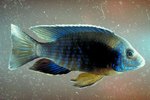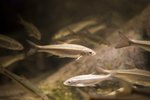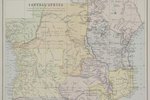
An African cichlid can grow to 4 to 10 inches at maturity, depending on the species. Adequate nutrition is obviously important to the fish's growth, but environmental quality also determine's a cichlid’s growth rate and his health over a lifetime. An African cichlid can live up to 10 years. Get your young cichlid off to a healthy start.
Offer a Balanced Diet
According to the University of Florida, African cichlids less than 8 weeks old will grow fastest given a diet that's 40 percent to 50 percent protein and 10 percent to 12 percent fat. A commercial trout diet is recommended for young African cichlids, as it will help them grow to their optimal length and aid in color formation as well. Beyond the juvenile phase, you should offer your cichlid a diet that consists of 32 percent to 42 percent protein and 7 percent to 10 percent fat.
Don't Overfeed
Juvenile cichlids, according to MIT, will grow faster if you give them the prescribed amount of food written on your commercial fish food twice a day. However, once your cichlid reaches maturity, feeding him only once a day will keep him in prime health and fend off illnesses associated with obesity. Note that it's completely normal for cichlids to "beg" for food even when they've had their fill -- in fact, if a cichlid doesn't beg, that may mean he is ill or overfed.
Maintain Water Quality
McDaniel College states that wild cichlids are accustomed to alkaline water with a pH of 8.0 to 9.0. MIT recommends beginning aquarists keep their cichlid tanks at a pH of 7.5, which may require adding a carbonate buffer to your water. Having your tank become too alkaline too quickly can raise ammonia levels and jeopardize your cichlid’s growth, so MIT suggests adding the buffer slowly over the course of a week. You will also need a heater to maintain a temperature of 80 degrees Fahrenheit, although African cichlids will tolerate temperatures between 74 degrees and 82 degrees Fahrenheit, says MIT. Use two half-strength heaters so they can serve one another as backup.
Manage Stress and Illness
Keeping illness and your cichlid’s stress at bay will promote his growth. If other tank mates are bullying him -- male cichlids will often fight to the death -- separate them. Arrange decorations so your cichlid has a place to hide to give him a sense of security. Also, be on the lookout for an illness called Malawi bloat. While a cichlid with this disease may appear to be growing quickly, the bloating is unnatural and fatal if left unaddressed. Other symptoms of Malawi bloat include decreased appetite, stringy white feces, lethargy and increased rate of breathing.
References
Photo Credits
-
Jupiterimages/Photos.com/Getty Images
Writer Bio
Low began writing professionally in 2005. She writes primarily about parenting, personal finance, health, beauty and fashion. Low holds a Bachelor of Arts in writing.



